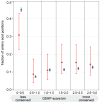Targeted investigation of the Neandertal genome by array-based sequence capture
- PMID: 20448179
- PMCID: PMC3140021
- DOI: 10.1126/science.1188046
Targeted investigation of the Neandertal genome by array-based sequence capture
Abstract
It is now possible to perform whole-genome shotgun sequencing as well as capture of specific genomic regions for extinct organisms. However, targeted resequencing of large parts of nuclear genomes has yet to be demonstrated for ancient DNA. Here we show that hybridization capture on microarrays can successfully recover more than a megabase of target regions from Neandertal DNA even in the presence of approximately 99.8% microbial DNA. Using this approach, we have sequenced approximately 14,000 protein-coding positions inferred to have changed on the human lineage since the last common ancestor shared with chimpanzees. By generating the sequence of one Neandertal and 50 present-day humans at these positions, we have identified 88 amino acid substitutions that have become fixed in humans since our divergence from the Neandertals.
Figures


Comment in
-
Genomics: Technical feat gives clues to human origins.Nat Rev Genet. 2010 Jul;11(7):456. doi: 10.1038/nrg2821. Nat Rev Genet. 2010. PMID: 20517343 No abstract available.
References
Publication types
MeSH terms
Substances
Grants and funding
LinkOut - more resources
Full Text Sources
Other Literature Sources

